| |
 
 | | | |
166 Solor Archipelago, Alor
Kafate (sarong)  
| | Locale: | West Alor, Bird's Head Peninsula, Adang speaking) people. | | Period: | 1920-1940 | | Yarn: | Cotton, hand-spun, medium | | Technique: | Warp ikat | | Panels: | 2 | | Size: | 58 x 119 cm (1' 10" x 3' 10") LW: 2.05 | | Weight: | 495 g (17.5 oz), 359 g/m2 (1.18 oz/ft2) | | Design: | Two wide bands in white on indigo with lozenges that are somewhat reminiscent of ikan pari, sting ray, and have a very slight directionality: those in the top ikated band appear to run left, those in the bottom to the right. motifs are alternately decorated with crosses and diamonds and have small hooks attached that suggest tentacles. These may have been inspired by Timorese kaif motifs, but also by a rare type of patola. The wide bands are bordered by narrower bands with arrays of dots. Midfield with narrow pinstripes, some a single thread wide. Two broad plain indigo bands towards the extremities bordered with narrow bands containing wavelike motifs. All natural dyes. The fact that only indigo was used marks it as a workaday sarong, not bridewealth; but, ironically, such cloths are now even more rare than the morinda bridewealth sarongs, such as PC 114. In fact, no other example appears to be known.Remarkably, the drawing is more intricate than on typical antique Alorese bridewealth sarongs. This suggests that the dating may have to be adjusted downward, closer to 1900. | | Comment: | Extremely rare, possibly unique early 20th C. Alor sarong. Most likely this is one of the last survivors of a style, a weaving culture, that disappeared - due to disaster, the movement of people, changing fashion, or the influence of missionaries - and disappeared with, so far, only this trace. Chelna Desai in Ikat Textiles of India on Fig. 13 shows a patola fragment with alternating pan leaves and lozenges with crosses that looks strikingly similar - vide the way the circle in the pan leaf connects to the frame, only on the left. Bühler & Fischer found this kind of patolu (which they classify as Type 1) in European museums and were not aware of specimens found in Indonesia, but clearly some did find their way to Indonesian islands - see also PC 307. On Alor, Pantar and Ternate patola were very important as dynastic symbols.
 | | Background: | Chapters on Solor Archipelago and Alor. | | Exhibited: | Museu do Oriente, Lisbon, 2014/15.
Hong Kong University Museum and Art Gallery, 2017. | | Published: |
Woven Languages, 2014.
HALI 181, 2014.
Ikat Textiles of the Indonesian Archipelago, 2018.
| | Compare: | 114 307 | | Sources: | No similar piece known from literature or public collections, not even in the Ernst Vatter collection, but the author photographed a woman in Sabandar, a hamlet in the Adang speaking part of the Bird's Head Peninsula in north-western Alor, sometimes refered to as the Kabola Peninsula, wearing a similar sarong in the same indigo palette, not normally associated with Alor, in 1981. See photo below. Barnes & Hunt Kahlenberg (2010:346, 347) ) show a Lembata sarong with a similar ikated band with what they call 'linked heart shapes', remarking that they 'almost certainly reflect a patola design'. We believe that the patola design in question is most likely the pan bhat (see PC 307
 | | |

©Peter ten Hoopen, 2025
All rights reserved.
|
|


